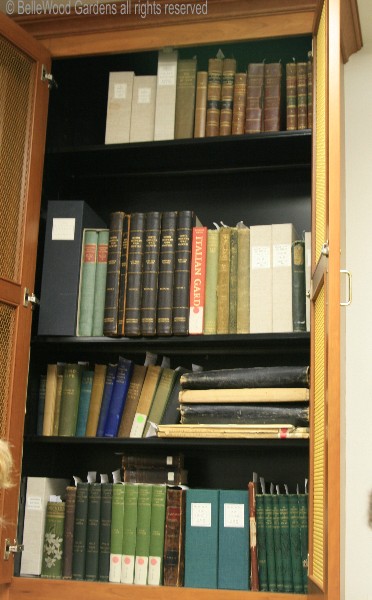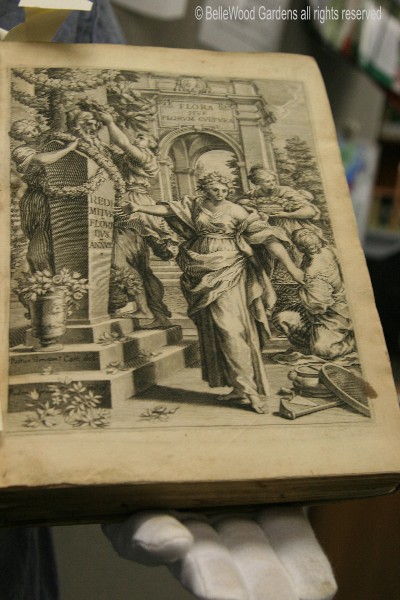
Friday, 22 July 2011 and Wednesday, 27 July 2011
The Gardener's Bookshelf: Fact and Fiction
Having completed our tour at Bamboo Brook we shuffled back into our cars and drove off to the Frelinghuysen Arboretum for lunch and more story tours. Revived with lunch (though perhaps it was the air conditioned comfort indoors that had something to do with it) my group congregated downstairs in the Julia Appleton Cross Horticultural Reference Library for a lecture on the archetypes of botanic literature. Lesley Parness, Director of Horticultural Education, has excellent display material for her presentation. In addition to the 2,000 or so more or less contemporary garden books available for loan to arboretum members, the library holds the Elizabeth Donnell Kay Rare Book Collection of 256 rare books on horticulture. Dating back as far as the 16th century the collection includes herbals, medical botanies, floras, floralegia, sylva, monographs, and volumes on plant exploration, natural history, landscape design and architecture.

The rare books are kept in several tall cabinets, behind locked doors.

On the left, a wood cut of a strawberry plant in the Hortus Sanitatis.
The oldest book - not merely the oldest in their collection but recognized as one of the oldest, most influential of the early herbals is the Hortus Sanitatis. Containing 1066 woodcuts, of which 530 depict herbs, The Garden of Health is believed to have been compiled by the printer Jacob Meydenbach and the first printing was in Mainz, in 1491. Also known as Ortus Sanitatis or The Origin of Health this Latin treatise in the tradition of medieval herbals is partly based on Der Gart der Gesundheit by Johann Wonnecke von Kaub. The treatise on plants is considerably modified from the German Herbarius, and the virtues of the herbs described are dealt with at greater length. The copy in the Frelinghuysen's library is the 1517 edition, still quite venerable.
All these ancient books require special care. Granted, the paper they are printed on is better than the disintegrating stuff that we use today, else how could they survive for centuries without crumbling away into dust. A torn page is likely to have been poorly repaired, and adhesive tape needs to be removed. Their binding is separating from the pages. Should the binding merely be restored, or is a facsimile of the original to be created. Stain reduction, washing, aqueous and non-aqueous deacidification, lining, mending, and in-painting. Make an acid-free box, like a slip case, to protect the book and its covers. Expensive care. Proceeds from two classes earlier this year at the Frelinghuysen Arboretum: archetypes of botanic literature and treasures of botanic illustration, were used for the conservation of rare books in their collection.

A woodcut illustration from the Plantarum Effigies, a small little book intended as a field guide.
Though the first edition of Leonhart Fuchs work, Plantarum Effigies and published in 1552, it is the second use of these small woodcuts figures by Clement Boussy. They first made an appearance in Fuch's De historia stirpium, printed in Lyon in 1549. The plants names are given in Greek, Latin, French, German, and Italian. The Plantarum Effigies is a pocket-sized version to be used in the field. It has very little text, apart from an index to the plants depicted, and with each woodcut the name of the plant is given in three or more languages, usually five - Greek, Latin, French, Italian and German.

Lesley had selected various books to develop her theme of archetypes and share with us the diversity of their rare book collection. After a brief discourse concerning each volume she would walk slowly down the aisle so we could have a closer look at illustration and / or text. This, I believe, is the elegant frontispiece from Giovanni Battista Ferrari's Senensis e Societate Iesu De Florum Cultura, published in Rome in 1633. It's focus is primarily on citrus, also narcissus, lilies, plants in pots, and flower arranging. It is an archetype of Hesperides, named for the nymphs living in a beautiful garden at the far western edge of the world (or perhaps merely the westernmost portion of the Mediterranean, near Mt. Atlas.)

Closer to home and if not contemporary at least only a couple of centuries back, Lesley shows us
an illustration by Redouté in François André Michaux's North American Sylva; or A Description
of The Forest Trees of The United States, Canada and Nova Scotia., the English language edition
published in 1819. Though perhaps best know for his monumental works on roses and lilies,
this poplar leaf is as fresh, as vibrant, and as accurate as when Redouté painted it two centuries ago.
Born in 1770, son of a remarkable and well known French botanist, André Michaux ,François André Michaux was an excellent botanist in his own right. His monumental work, Histoire des arbres forestiers de l'Amérique septentrionale was first published from 1810 to 1813, in three volumes, in French. The English translation was made between 1811 and 1819 with the title The North American Sylva. With illustrations by Pierre Joseph Redouté and Pancrace Bessa, two masters of botanical art, his opus rapidly became a landmark in American horticultural literature and the comprehensive foundation of American forestry.
.
Fast forward a few days to Wednesday, 27 July 2011. The Tohickon Garden Club is having its monthly meeting. We're sitting on the shady patio of a member's home. It's July. It's hot. We needed a program that's light, entertaining, and uncomplicated. Part the first is a demonstration / lecture on flower arranging, geared towards classes in our standard flower show scheduled for September. Next are members sharing their favorite garden book, describing in a few words why they chose each title. The contemporaneous gardener's bookshelf. I confess, when I suggested the topic to the club's cochairmen I was very curious as to what people would share as their favorites. Publishing is in turmoil these days. There are ebooks, to be read on an iPad or Kindle. The major player big box chain bookstore, Borders, went bankrupt. People look on line for snippets of information. I do too, but there's something about "real" books, books that have heft and substance, that can be referred to again and again.

Not too surprisingly, a couple of members selected books about
flower arranging. Pat has one from the garden club's own library
and Grace is contemplative while watching Sue's demonstration.

Clearly there's a book for everyone. Last year one of our members grew 17 different kinds of melons. She chose to tell us about Amy Goldman's melon book, Melons for the Passionate Grower. The photographs by Victor Schrager are luscious enough to make you drool. Why this book? Because she loves melons and basically what's available at the supermarket are watermelons, cantaloupes, maybe honeydew. There's a world of melons out there . . . . .
I was interested to see how many members chose encyclopedias and compendiums: Michael Dirr's Hardy Tree's and Shrubs; American Horticultural Society: Northeast Smart Garden Guide; Ellen Phillips & C. Colston Burrell's Illustrated Encyclopedia of Perennials; Richard Bird's Knowing and Growing Annuals & Perennials and, given the season, books on vegetable gardening.

.

Of course, if you have a garden it must be cared for. Norma's favorite
is The Well-Tended Perennial Garden by Tracy DiSabato Aust.

As well as how-to and what to grow we need something entertaining and amusing to read. Carol Ann was not alone in recommending Merry Hall by Beverly Nichols. There are a number of his books that I enjoy - for example Sunlight on the Lawn, Garden Open Today, Garden Open Tomorrow. They've recently been reprinted by Timber Press, so you needn't haunt used bookstores to find them.
And then it was my turn. I had a difficult time deciding. My study is nearly walled with bookshelves. Where to start? Native plants, maybe bulbs, perhaps water gardening . . . . . I couldn't settle on a subject. So I came at choosing a theme through the back door, starting with a novel. Now, admittedly I have problems with novels that have plants and gardens woven in to the fabric of their story. Often plants are flowering out of season, or growing in the wrong place, or some other infelicitous error that sets my teeth on edge. The author should get these details right, just as much as whether the butler did it.
Susan Wittig Albert does a good job with her China Bayles mysteries. Each book in the series has an herb theme, there are brief quotes that lead each chapter, and a couple of recipes at the end of the book. So I started with Chile Death. That gave me my theme of herbs / herbals. From pure fiction I moved on to a factual book inspired by fiction, Brother Cadfael's Herb Garden, by Rob Talbot and Robin Whiteman. Brother Cadfael is the herbalist at Shrewsbury Benedictine monastery, central to Ellis Peter's mystery novels set in the 12th century. Talbot and Whiteman's book begins with a lovely discussion of herbals, monastery gardens, and other solid foundations before mentioning individual herbs mentioned in the novels. Reference to specific books, a quote from one or two, and the herb's uses complete each entry, enhanced with lovely photographs.
Next I pulled Ethne Clarke's excellent book on Herb Garden Design. Sound information for gardens large and small, formal and casual, in the ground or grown in pots. Lovely photographs by Clive Nichols, and evocative watercolors images of various of the gardens. Then I wanted a how-to-grow srot of book. A reliable source about care, cultivation, selection, and use of herbs is to be found in Gertrude B. Foster's Herbs for Every Garden. Published in 1966 before color became mandatory, there are a few black and white photographs and a sparse handful of drawings. Back then, you see, information was a book's raison d'etre, rather than pretty pictures. Lastly, dipping back in time to 1851 I chose The Family Kitchen Gardener, containing Plain and Accurate Descriptions of All the Different Species and varieties of the Culinary Vegetables; . . . . . and Medicinal Herbs in General Use. No questions about the contents of this little book. Robert Buist focuses more on vegetables but offers several paragraphs discoursing about herbs. Pleasant for comparison to more recent works on the topic.
With A Meme of Garden Books in an earlier BelleWood Gardens entry, I asked friends to talk about their favorite gardening books. Take a look and see if you find their responses as interesting as I do. Do you have favorite fact-or-fiction books about gardening that you'd like to share? Contact Me if you want to have your say.